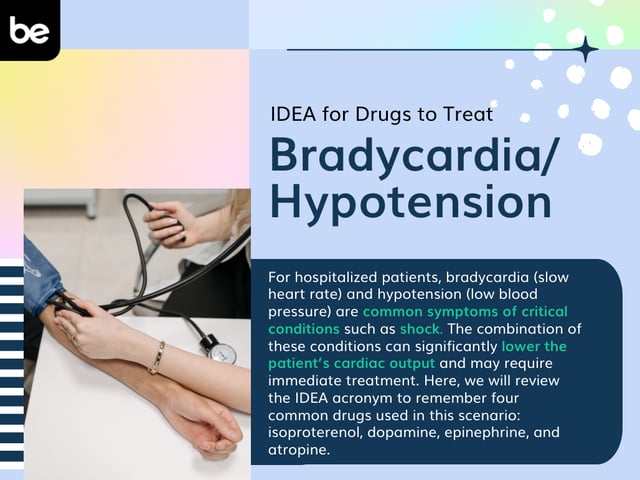
IDEA for Drugs to Treat Bradycardia/Hypotension
For hospitalized patients, bradycardia (slow heart rate) and hypotension (low blood pressure) are common symptoms of critical conditions such as shock. The combination of these conditions can significantly lower the patient’s cardiac output and may require immediate treatment. Here, we will review the IDEA acronym to remember four common drugs used in this scenario: isoproterenol, dopamine, epinephrine, and atropine.
I—Isoproterenol
Isoproterenol is administered intravenously in this context and acts on beta-1 and beta-2 adrenergic receptors. Beta-1 adrenergic receptors are located primarily in heart tissue cells and cause the heart rate to increase and heart contractility to increase. Beta-2 adrenergic receptors are found in the bronchi and smooth muscle cells, which causes peripheral vasodilation. Side effects of isoproterenol can include headaches, palpitations, and/or tachycardia.
D—Dopamine
Dopamine is administered intravenously and causes vasodilation, including in the kidneys, in small doses. It acts on beta-1 adrenergic receptors in medium doses to increase cardiac output. In high doses, it acts on alpha-1 adrenergic receptors, causing vasoconstriction. When administering dopamine, the nurse should monitor the patient’s blood pressure and urine output. Side effects of dopamine may include nausea, vomiting, and/or dyspnea.
E—Epinephrine
Epinephrine can be administered multiple ways but is used intravenously or intramuscularly in this context. Epinephrine acts on alpha-1, beta-1, and beta-2 receptors to stimulate cardiac muscle tissues, increasing contractility, and causes vasoconstriction to increase blood pressure. Side effects of epinephrine can include anxiety, headache, nausea, and/or vomiting.
A—Atropine
Atropine can be administered in multiple ways but is used intravenously in this context. Atropine is an anticholinergic drug that acts on the smooth muscle to increase heart rate and cardiac output. Side effects of atropine can include blurred vision and/or tachycardia.
To learn other helpful nursing acronyms, or for help studying for your upcoming NCLEX exam, check out our free NCLEX-RN practice tests, study guides, and flashcards.
Keep Reading

National Council Licensure Examination-Registered Nurse Blog
What to Expect in Nursing School Clinicals
The clinical experience is a rite of passage for all nursing students, …

National Council Licensure Examination-Registered Nurse Blog
What is the NCLEX Next Generation (NGN) Exam?
If you’re interested in becoming a registered nurse, you likely know th…

National Council Licensure Examination-Registered Nurse Blog
SAMS for Lidocaine Toxicity
Lidocaine is a commonly used local anesthetic drug and can be used for …